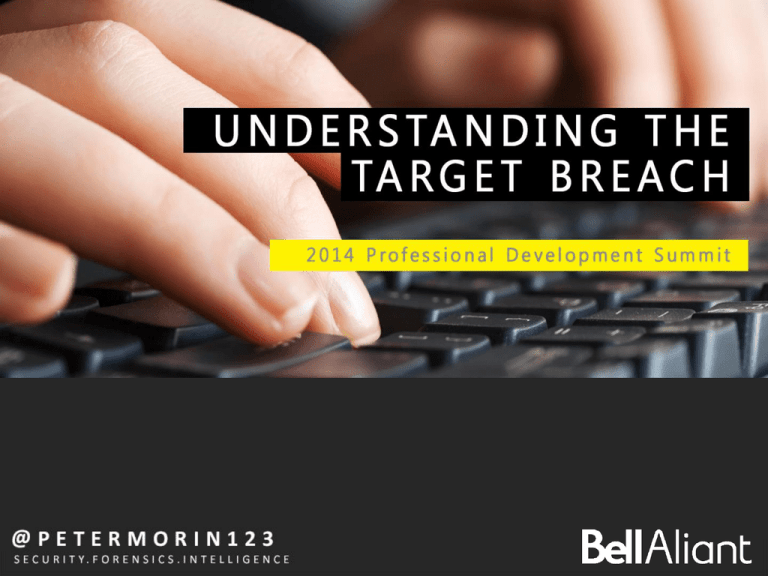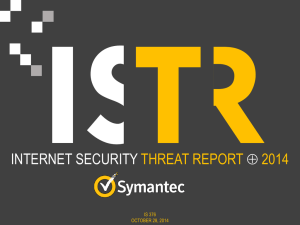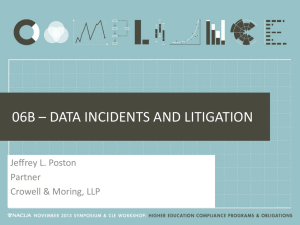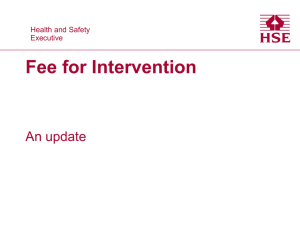File - Professional Development Summit
advertisement

Welcome & Thanks for Having Me!! @petermorin123 Introduction – Peter Morin • Who Am I? – 20+ years experience in Information technology – 12 of those in InfoSec. – Senior information security consultant for Bell Aliant – Been teaching for about 8 years (i.e. SANS, US Federal Government, US Army, etc.) – Worked for KPMG and Ernst & Young – International Executive board for the High Technology Crime Investigation Association – CISSP, CISA, CGEIT, CRISC, GCFA, GCIH @petermorin123 Agenda • I want you to take home four important points: • • • • Understand Educate Collaborate Prepare • Look at the Telus / Rotman Survey • Profile some of the threat actors • Look at the impact of four of the most common types of attacks today. • Look at a quick case study – Target breach @petermorin123 Blurring of Activities • The traditional corporate perimeter, with clearly identifiable boundaries, has diminished. • Firewalls become useless – Data is being shared in ways that current security models may not have considered = Data leakage • Focus is on keeping bad guys out, not data in! • It is the norm for workers to blend business and personal use (i.e. social networks) - further blurring the network perimeter @petermorin123 Blurring of Activities • Traditional in-sourcing has taken a back seat • We are outsourcing more and more to organizations that specialize in the services we are looking for • • • • • • IT service management Website hosting Application hosting Offsite backups Management of critical systems Etc… @petermorin123 Who Gets Attacked? • Nobody is immune – Multinationals to small business to governments – Across all industries – Attacker tactics are numerous and non-stop @petermorin123 Who Gets Attacked? • Nobody is immune – even from stateaffiliated espionage • State-affiliated actors perpetrated 19% of attacks last year • Targets are not government agencies, and not just military contractors • Be aware of the “knock-on effect” in your supply chain 2013 Verizon DBIR @petermorin123 Who Are the Attackers? • Varied Motivations • AIM IS TO MAXIMIZE DISRUPTION • EMBARRASS VICTIMS FROM BOTH PUBLIC AND PRIVATE SECTOR. • MOTIVATED BY FINANCIAL GAIN • WILL TAKE ANY DATA THAT MIGHT HAVE FINANCIAL VALUE. • OFTEN STATE-SPONSORED • DRIVEN TO GET EXACTLY WHAT THEY WANT - FROM INTELLECTUAL PROPERTY TO INSIDER INFORMATION. @petermorin123 Who Are the Attackers? • Varied Tactics • USE VERY BASIC METHODS AND ARE OPPORTUNISTIC. • RELY ON SHEER NUMBERS. • MORE CALCULATED AND COMPLEX THAN ACTIVISTS IN HOW THEY CHOSE THEIR TARGETS. • CRIMINALS ARE NOW TRADING INFORMATION FOR CASH. • OFTEN STATE-SPONSORED, USE MOST SOPHISTICATED TOOLS TO COMMIT MOST TARGETED ATTACKS. • TEND TO BE RELENTLESS. @petermorin123 What to Worry About? • This year’s biggest threats? Same as last year’s. – Very few surprises – mostly variations on theme – 75% of breaches were driven by financial motives – 95% of espionage relied on plain-old phishing • Well established threats shouldn’t be ignored @petermorin123 What to Worry About? • What do attackers target? Still the traditional assets. – It’s still traditional assets (laptops, desktops and servers) that are most at risk — not just web applications. – Unapproved hardware (such as personal storage devices) accounts for 41% of the cases of misuse @petermorin123 What to Worry About? • Many data breaches have an unintentional element. People across the company. 2013 Verizon DBIR Taking information home, copying data onto a USB drive, attaching the wrong file to an email or sending it to the wrong person, or leaving a laptop in a cab can all lead to a data breach. @petermorin123 What to Worry About? • Who discovered them? Outsiders such as customers – Can be a scary moment! OF BREACHES WERE SPOTTED BY AN EXTERNAL PARTY. OF BREACHES WERE DISCOVERED BY CUSTOMERS. 2013 Verizon DBIR @petermorin123 What to Worry About? • Minimal time to compromise • IN 84% OF CASES, INITIAL COMPROMISE TOOK HOURS OR LESS. 2013 Verizon DBIR @petermorin123 What to Worry About? • Minimal time to compromise. But a long time to discovery. • IN 66% OF CASES, THE BREACH WASN’T DISCOVERED FOR MONTHS OR EVEN YEARS. 2013 Verizon DBIR @petermorin123 2013/2014 Notable Breaches The retail store chain acknowledged that up to 110 million customer records (i.e. payment cards) were compromised in a data breach that occurred in the busy Thanksgiving shopping period. 1.1M credit cards were stolen in this breach. The hackers moved unnoticed in the company’s computers for more than eight months, setting off 60,000 unnoticed alerts as they moved around the victim’s network. @petermorin123 2013/2014 Notable Breaches In June, Facebook disclosed an estimated 6 million Facebook users had e-mail addresses or telephone numbers shared with others due to a software bug in the “Download Your Information” found by a security researcher and reported to Facebook, which fixed it. Adobe said attacks dating to at least August had exposed user IDs, passwords and credit-card information (stored in encrypted form) on about 2.9 million customers. @petermorin123 2013/2014 Notable Breaches The financial services firm said a cyber-attack resulted in the compromise of personal information about almost half a million corporate and government clients who held prepaid cash cards issued by JP Morgan Chase. The cord-blood bank agreed to settle Federal Trade Commission charges it failed to protect customer data due to inadequate security that exposed Social Security and credit-card information on 300,000 people. @petermorin123 2013/2014 Notable Breaches Travel health and security services company International SOS in November said information on 164,000 people, including their e-mail, passport numbers and travel information, was accessed by an “unauthorized third party.” The bank acknowledged 150,000 records related to bankruptcies and other legal proceedings was inadvertently exposed. @petermorin123 2013/2014 Notable Breaches The federal agency disclosed that data on 104,179 employees was compromised in a cyber-security incident in July. The U.S. Internal Revenue Service mistakenly posted tens of thousands of names, addresses and Social Security numbers — perhaps as many as 100,000 - - on a government website, a discovery made in July by a group called Public.Resource.org. @petermorin123 2013/2014 Notable Breaches The university, known as Virginia Tech, disclosed a breach that exposed about 145,000 records of people who had applied for jobs over the past decade. Heartbleed - breach on the CRA’s website, which resulted in roughly 900 social insurance numbers being stolen. RCMP arrested Stephen Arthuro SolisReyes, of London, Ont., at his home on April 15. @petermorin123 @petermorin123 Asked CIOs/CISOs… “What keeps you up at night?” @petermorin123 2013 Telus/Rotman Study • The biggest challenge is people. • Security is only as good as the people who adhere to your policies and security measures. • Organizations are always at risk if employees aren’t aware of security. @petermorin123 2013 Telus/Rotman Study • We have all been breached, whether we know it or not. • The presence of data, in even what appears to be well-protected environments, very often means a user is one click away from doing something very dangerous accidentally, and we don’t always know how to manage that. @petermorin123 2013 Telus/Rotman Study • Other organizations having experienced very public breaches allows us to have a very different kind of conversation with the board and with the executive team. • Off-shoring and outsourcing poke more and more holes in my perimeter - the erosion of traditional perimeters is a big concern to me @petermorin123 2013 Telus/Rotman Study • Our number one threat concern - loss of trust in our ability to protect customer data. • Being a custodian of customer data is a driver for security. • Employees are our single greatest threat – it’s not malicious, it’s just not knowing. • We can influence our employees and make them aware, but we can’t control their actions. @petermorin123 2013 Telus/Rotman Study • We need to have the controls and tools in place to protect [corporate data on mobile devices]. • Conversely, if we weren’t set up with the right foundational tools like mobile device management then it would be a red herring for us. @petermorin123 Understanding the Attacker: Common Attack Profile @petermorin123 Common Attack Profile • If your organization understands that there is no such thing as perfect security = You’re halfway there! • Advances in technology will always outpace our ability to effectively secure our networks from attackers • This is what is referred to as the “Security Gap” = nothing we can do about it! @petermorin123 Common Attack Profile • Look at the tactics that the adversary is using to compromise organizations – The subversion of IT contractors – The extensive reconnaissance used by attacker – The persistent re-compromise of valuable targets – Strategic web compromises • These four trends are about the business side of exploitation. @petermorin123 Subversion of IT Contractors • Lots of outsourcing in 2013! – $134B on finance, accounting, HR, and procurement – $252B spent on IT outsourcing • Organizations allowing vendors unfettered access to large portions of their networks. • 2003 also saw an increase in the number of outsourced providers who were compromised @petermorin123 Subversion of IT Contractors • Attackers compromise the first victim, the outsourcer • Gather the intelligence they need to facilitate their compromise of the second victim • Lay dormant at the first victim for months (or even years) • Only accessing backdoors at those companies if they need to regain access to the second victim. @petermorin123 Extensive Recon Used by Attackers • Comprehensive network reconnaissance allows attackers to navigate victims’ networks faster and more effectively. • Attackers can steal the data they want faster when they know where to look for it. • Basic reconnaissance of victim networks is nothing new • In 2013 we noted evidence of attackers expanding the type of reconnaissance they perform and utilizing more sophisticated tools and to map victims’ networks. @petermorin123 Extensive Recon Used by Attackers • The first documents the attackers frequently stole were related to network infrastructure, processing methodologies and payment card industry (PCI) audit data. • The attackers also took various system administration guides to identify human targets and to further scope the victim networks. @petermorin123 Extensive Recon Used by Attackers • Using this info, attackers identified network and system mis-configurations which they exploited to gain greater access within the network. • This is what we call “pivoting” • Increased intel = faster and more direct access to the areas of their victims’ networks that they were trying to compromise. @petermorin123 Extensive Recon Used by Attackers • In some instances, attackers sought entry to production environments where they stole intellectual property. • In other cases, they were looking to identify network resources the victim shared with other organizations that were also on the attacker’s target list. @petermorin123 Extensive Recon Used by Attackers @petermorin123 Re-Compromise of Valuable Targets • Attackers continue to target industries that are strategic to their growth – telecom, aerospace, software, high-tech services, and energy, etc. • Attackers choose their targets for different reasons – financially motivated attackers seek victims who they can easily can gain access to in order to steal money or credit/debit card numbers @petermorin123 Re-Compromise of Valuable Targets • Attackers conducting economic espionage are motivated by economic gain and their victims are often directly correlated with their national interest. • Larger number of situations where organizations that were initially compromised were repeatedly attacked once those organizations had cleaned up from the breach. @petermorin123 Re-Compromise of Valuable Targets @petermorin123 Strategic Web Compromises • We know… – Attackers have long used spear phishing and other social engineering tactics to entice users to click on malicious files they receive via email. – They send the target a well-crafted email with an attachment, the target clicks on the attachment, their machine becomes compromised, and the attacker gains access to the victim’s network. @petermorin123 Strategic Web Compromises • So attackers have… – As the use of this well-known technique has become more prevalent, technologies have been developed to combat these attacks — and they continue to improve. – Attackers shift tactics by placing exploits on websites they know are frequently browsed by users in targeted organizations @petermorin123 Strategic Web Compromises • Targeted users travel to the compromised website as part of their daily operations • Click on the compromised website, malware is installed on their machines • Malware collects usernames, passwords, browser cookies and the computer name @petermorin123 Strategic Web Compromises • By using these strategic web compromise attacks, the attacker… • Able to secure access to multiple individuals’ systems within several targeted companies without having to send a single email • Attacker can defeat anti-phishing technology • Exploiting web servers used to be a crime of opportunity not a targeted, pre-meditated attack @petermorin123 Case Study: Breach at Target @petermorin123 Target Breach • PCI-DSS compliant • Re-certified in September 2013 • Used advanced systems from vendors such as FireEye and Symantec • Large dedicated security team • Maintain a 24/7 security operations center • Target security staff raised concerns about vulnerabilities in the retailer’s payment card system at least two months before the attack • 40M CC/debit numbers stolen • Additionally, 70M accounts were compromised that included addresses and mobile numbers. @petermorin123 Target Breach @petermorin123 Target Breach • Network access to an third-party vendor, who did not appear to follow broadly accepted information security practices (Phishing!) • The vendor’s weak security allowed the attackers to gain a foothold in Target’s network • Target failed to respond to multiple automated warnings from their anti-intrusion software after the attackers were installing malware on Target’s systems @petermorin123 Target Breach • Initial intrusion into its systems was traced back to network credentials that were stolen from a third party vendor • Fazio Mechanical Services, a Sharpsburg, Penn.based provider of refrigeration and HVAC systems • Vendor in question was a refrigeration, heating and air conditioning subcontractor that has worked at a number of locations at Target and other top retailers. @petermorin123 Target Breach • Fazio’s data connection with Target was for electronic billing, contract submission and project management, and • They noted that Target is the only customer for whom they manage these processes on a remote basis (i.e. Trader Joe’s, Sam’s Club, etc.) @petermorin123 Target Breach • Attackers who infiltrated the network with vendor’s credential successfully moved from less sensitive areas of Target’s network to areas storing consumer data (no isolation!) • Target failed to respond to multiple warnings from anti-intrusion software regarding the escape routes the attackers planned to use to exfiltrate data from Target’s network @petermorin123 Target Breach • Malware used developed by 17 year old Russian • Malware used a so-called “RAM scraping” attack • Allowed for the collection of unencrypted data as it passed through the infected POS machine’s memory before transfer to the company’s payment processing provider. • “BlackPOS” malware available on black market forums for between $1,800 and $2,300 @petermorin123 Important Dates • Attackers first installed malware on a small number of POS terminals between November 15 and November 28, 2013 (soak in period) • Majority of Target’s POS system infected by November 30, 2013 • Attackers first gained access to Target’s internal network on November 12, 2013 • Target’s Symantec antivirus software also detected malicious behavior around November 28, implicating the same server flagged by FireEye’s software @petermorin123 Target Breach • Use of data drop sites – Compromised computers in the US and elsewhere that were used to store the stolen data and that could be safely accessed by the suspected perpetrators in Eastern Europe and Russia. – Card data stolen from Target’s network was stashed on hacked computer servers belonging to businesses in Miami and Brazil. @petermorin123 Target Breach • But PCI requirements protect us right? • PCI standard does not require organizations to maintain separate networks for payment and nonpayment operations • It does require merchants to use two-factor authentication for remote network access originating from outside the network by personnel and all third parties — including vendor access for support or maintenance (see section 8.3). @petermorin123 Target Breach • It is estimated that Target could be facing losses of up to $420 million as a result of this breach - Including… – Reimbursement associated with banks recovering the costs of reissuing millions of cards – Fines from the card brands for PCI non-compliance – Direct Target customer service costs, including legal fees and credit monitoring for tens of millions of customers impacted by the breach. @petermorin123 Target Breach • But wait…there’s more… – Estimates do not take into account the amounts Target will spend on implementing technology to accept chip-and-PIN credit and debit cards. – In testimony on Capitol Hill, Target’s CFO said upgrading the retailer’s systems to handle chipand-PIN could cost $100 million. @petermorin123 In Conclusion… • What can I do? – Focus on data leakage protection - Apply the appropriate data classifications to such information and secure it accordingly – Understand not only your weaknesses, but also those of your partners’ - Your network is only as secure as your outsourced service provider - apply as stringent policies to their access as you would to your own employees. – Pen-tests - Have a third party regularly assess your networks and systems using “real world” methodsa @petermorin123 In Conclusion… • What can I do? – Treat incident detection and response as a consistent business process — not just something you do reactively. – Understand the threat landscape • Advanced attackers are no longer relying solely on vulnerable web applications and phishing emails to gain access to targeted companies. • They are targeting individuals, conducting reconnaissance, and are willing to lie in wait while a user acts to compromise themselves. – Build intel into your operation - Ensure that security operations incorporate data from intelligence services to identify when domains are compromised – Awareness is key – train employees (i.e. no USB sticks!!) @petermorin123 Questions? Comments? Peter Morin petermorin123@gmail.com Twitter: @petermorin123 http://www.petermorin.com @petermorin123









